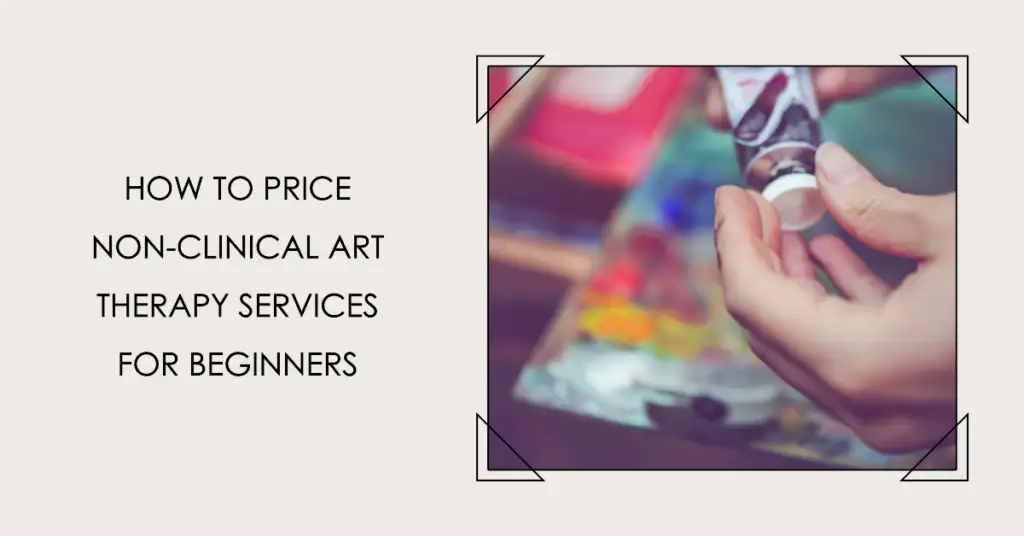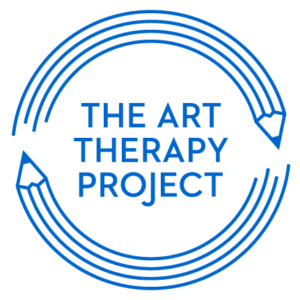How to Price Non-Clinical Art Therapy Services for Beginners

If you’re a budding art therapist or therapeutic art facilitator, pricing your non-clinical art therapy services can be challenging, especially if you have no experience. In this guide, we’ll debunk common pricing myths, explore the factors that determine the value of your services, and provide a simple method for setting your fees. By understanding and applying these principles, you can confidently establish the right pricing structure for your business.
Debunking Common Pricing Myths
Before we dive into the factors that should influence your pricing, let’s debunk some common myths that can negatively impact your pricing strategy.
Myth #1: Online and non-clinical sessions must be priced lower
Contrary to popular belief, your service’s value and pricing don’t have to be lower simply because it’s non-clinical or offered online. In fact, online sessions can be even more valuable to some clients, as they provide access to your unique services without geographical constraints. Embrace the potential of online sessions and avoid undervaluing your services.
Myth #2: Pricing should be based on the ease of delivering the session
The perceived ease of delivering a session shouldn’t determine its price. If anything, the easier a session is for you to deliver, the better you’ve become at your skill, which should be reflected in a higher price.
Myth #3: Pricing should be based on what others are charging
While it’s common to base your pricing on what others in the industry are charging, it’s essential to remember that your services are unique. Consider your specific situation, target audience, and value proposition when setting your prices.
Understanding the True Value of Your Services
Now that we’ve debunked common pricing myths, let’s discuss what pricing is really about. At its core, pricing represents the value your services provide to your clients. The primary factors that determine the value of your art therapy services include:
- The transformation and meaning your services provide in clients’ lives.
- The level of commitment and investment clients are willing to make.
- Your perception of the value of your services.
- The alignment of your pricing with your business goals and vision.
By understanding these factors, you can confidently price your services in a way that reflects their true value.
The “Numbers” Method for Pricing Your Services
To make pricing your non-clinical therapeutic art sessions more straightforward, consider using the “Numbers” method. Here’s how it works:
- Determine your desired monthly income.
- Decide how many clients or sessions you’d like to offer per month.
- Divide your desired monthly income by the number of sessions to calculate a per-session fee.
As a beginner, you may want to set your initial pricing slightly lower to build experience and a solid client base. Once you’ve established a steady income, consider raising your prices to better reflect your skills and experience.
Remember, this is just one method for pricing your services. You should also consider your unique business goals and any pricing strategies that align with them.
Exploring Authoritative Websites for Pricing Insights
As you build your art therapy practice, it’s essential to understand the current market trends and pricing strategies in the field. High domain authority websites can provide valuable insights and resources to help you make informed decisions about pricing your services. Here are some reliable websites to consider exploring:
1. American Art Therapy Association (AATA)
AATA is a professional organization dedicated to promoting the field of art therapy. Their website offers a wealth of resources, including articles and research, that can help you stay informed about the latest industry trends, including pricing strategies and best practices.
2. GoodTherapy
GoodTherapy is a popular online directory and resource center for therapists and clients. Their blog often features articles about various aspects of therapy, including pricing and business management tips. This can be an excellent source of information for understanding the market and learning from the experiences of other professionals.
3. Art Therapy Credentials Board (ATCB)
ATCB is a non-profit organization responsible for credentialing art therapists in the United States. Their website offers resources and guidance for art therapists at various stages of their careers. By staying informed about credentialing and professional standards, you can better understand how these factors may influence your pricing decisions.
Common Pricing Models for Art Therapy Services
In addition to the “Numbers” method, there are several common pricing models you can consider when setting fees for your art therapy services. Understanding these models can help you choose the best approach for your business.
1. Flat Rate
A flat rate pricing model involves charging a fixed fee for each session, regardless of its length or complexity. This model offers simplicity for both you and your clients, as everyone knows the cost upfront.
2. Tiered Pricing
Tiered pricing allows you to offer different levels of service at varying price points. For example, you might offer a basic, standard, and premium package, each with different features, session lengths, or additional resources. This model can cater to clients with diverse needs and budgets.
3. Sliding Scale
A sliding scale pricing model adjusts fees based on clients’ ability to pay. This approach can make your services more accessible to a wider range of clients, but it may require additional administrative work to determine appropriate fees for each individual.
4. Subscription or Membership Model
A subscription or membership model involves clients paying a recurring fee for ongoing access to your services. This could include a set number of sessions per month, unlimited access to group sessions, or access to additional resources and support.
Summary of Pricing Models
| Pricing Model | Description | Pros | Cons |
|---|---|---|---|
| Flat Rate | Charge a fixed fee for each session, regardless of length or complexity. | Simple for both clients and therapists. | May not accommodate varying needs. |
| Tiered Pricing | Offer different levels of service at varying price points (e.g., basic, standard, and premium). | Caters to clients with diverse needs. | Requires careful planning and pricing. |
| Sliding Scale | Adjust fees based on clients’ ability to pay. | Increases accessibility for clients. | Requires additional administrative work. |
| Subscription Model | Charge a recurring fee for ongoing access to services. | Provides predictable, recurring revenue. | May require more ongoing support. |
Tips for Communicating Your Pricing and Value
Effectively communicating the value of your services and justifying your prices is essential for attracting and retaining clients. Consider these tips for showcasing your offerings and fees.
1. Be Transparent
Clearly display your pricing on your website and marketing materials. This transparency can help clients understand what to expect and reduce the likelihood of sticker shock or confusion.
2. Highlight Your Credentials
Emphasize your accreditation and membership with organizations like IPHM, CMA, and CPD to showcase your credibility and expertise.
3. Showcase Testimonials and Success Stories
Feature client testimonials and success stories to demonstrate the real-world impact and value of your services. This social proof can be a powerful tool in persuading potential clients to invest in your offerings.
4. Offer a Free Consultation or Trial Session
Consider offering a free consultation or trial session to allow potential clients to experience your services firsthand. This can help them better understand the value you provide and feel more confident in their decision to invest.
Summary of Tips for Communicating Pricing and Value
| Tip | Description |
|---|---|
| Be Transparent | Clearly display pricing on your website and marketing materials to reduce confusion and set expectations. |
| Highlight Your Credentials | Emphasize your accreditation and memberships to showcase your credibility and expertise. |
| Showcase Testimonials and Success Stories | Use client testimonials and success stories to demonstrate the real-world impact and value of your services. |
| Offer a Free Consultation or Trial Session | Provide potential clients with the opportunity to experience your services firsthand, helping them understand the value you provide. |
Final Thoughts
Pricing your non-clinical art therapy services as a beginner can be a challenging task. However, by understanding the true value of your services, debunking common pricing myths, and using the “Numbers” method, you can establish a pricing structure that accurately reflects the value you provide to your clients.
Don’t forget to consider your accreditation and membership with organizations like the CMA and CPD when setting your prices, as these credentials can enhance your credibility and justify higher fees.
As you gain experience and confidence in your skills, be sure to revisit your pricing strategy regularly to ensure it remains aligned with your business goals and the value you provide. You may also want to explore art therapy techniques and activities for specific conditions to broaden your service offerings and better serve your clients.
If you’re considering a career in art therapy, take our quiz to determine if you’re an ideal candidate for becoming an art therapy practitioner. To further your education, consider enrolling in our Art Therapy Practitioner Training Course to gain the knowledge and skills necessary for a successful career in this rewarding field.
By offering valuable services, setting appropriate prices, and continuously honing your skills, you’ll be well on your way to building a thriving art therapy business that benefits both you and your clients. Happy pricing!
Frequently Asked Questions (FAQ)
Q: How do I determine the right pricing model for my art therapy services?
A: Consider your target clientele, business goals, and the value you provide when choosing a pricing model. It may be helpful to research competitors in your area and analyze their pricing structures to better understand the market.
Q: Should I offer discounts or promotional pricing?
A: Offering discounts or promotional pricing can be a useful strategy for attracting new clients or incentivizing existing clients to book more sessions. However, it’s important to ensure that your pricing still reflects the value of your services and allows you to cover your costs and generate a profit.
Q: How often should I reevaluate my pricing?
A: It’s a good idea to review your pricing at least annually, or more frequently if your costs, market conditions, or business goals change significantly. Regularly assessing your pricing ensures that it remains aligned with the value you provide and the needs of your clients.
Q: How do I handle clients who question my pricing or ask for a discount?
A: Be prepared to clearly explain the value of your services and the factors that contribute to your pricing, such as your expertise, accreditation, and the results you deliver. If a client requests a discount, consider offering a sliding scale or payment plan to make your services more accessible while maintaining the integrity of your pricing structure.
Q: Can I charge more for specialized services or working with specific populations?
A: Yes, you can charge higher fees for specialized services or working with specific populations, such as individuals with complex needs or those requiring specialized techniques. This can help you better meet the needs of diverse clients while justifying higher prices for your expertise and specialized skills.
Additional Resources for Art Therapy Practitioners
To further enhance your knowledge and skills as an art therapy practitioner, it’s essential to explore various resources that can provide valuable information, support, and inspiration. Here are some noteworthy resources to consider.
1. British Association of Art Therapists (BAAT)
BAAT is a professional organization representing art therapists in the United Kingdom. They offer a range of resources, including professional development opportunities, networking events, and a vast library of articles and research.
2. The Art Therapy Project
The Art Therapy Project is a non-profit organization providing art therapy services to individuals and communities in need. Their website features a blog with inspiring stories and insights from the field, as well as resources for art therapists looking to make a difference in their community.
3. Art Therapy Spot
Art Therapy Spot is a blog and resource center created by an art therapist. The website offers a wealth of information, including art therapy techniques, creative prompts, and insights into the therapist’s personal experiences in the field.















Responses